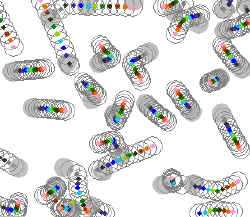An Ideal Gas of Beads

Violently shaking a box of breakfast cereal does not make the particles act exactly like molecules in an ideal gas, but there are similarities. According to the 23 October PRL there is a simple mathematical expression for the distribution of particle velocities in a shaken box of steel beads which–like the formula for gas molecules–depends only on the average speed of the particles and not on the density or details of the shaking. To model problems such as grain motion in silos, soil shifting in earthquakes, and dry foods mixing in processing plants, physicists studying granular materials want equations as simple and comprehensive as those for gases and fluid motion. The new results suggest that such a theory may be possible.
The century-old kinetic theory of gases assumes the gas molecules are in equilibrium with their surroundings–they exchange energy with the outside world each time a molecule collides with a wall. But the particles in a granular material are not in equilibrium; they constantly soak up energy from the shaking source because they heat up a bit with each interparticle collision, explains Narayanan Menon of the University of Massachusetts at Amherst. It’s not obvious that a kinetic-type theory for granular materials is even possible for such a nonequilibrium system, Menon says.
In search of some “universal” behavior, Menon and colleague Florence Rouyer used a high-speed video camera to measure the velocities of 1.6-mm-diameter steel beads confined between two vertical, clear plastic plates separated by 1.7 mm and sealed around the edges. Their mechanical shaker vibrated the cell vertically with accelerations up to 58 times that of gravity and speeds up to 1.8 m/s. Above a shaking speed of 1 m/s Menon says the particles “forget the influence of the boundaries” that pump in energy from above and below.
Under these conditions, Rouyer and Menon found a simple, bell-shaped distribution for the probability of each horizontal velocity, although not the classic Gaussian curve from kinetic theory. Instead their distribution is broader, with more particles having higher velocities. But the distribution’s shape was unchanged by variations in the frequency and amplitude of the shaking and the density of the particles. Even a circular cell gave the same distribution as a square one. And just as with an ideal gas, the distribution’s width depended only upon the average speed of a particle–the granular equivalent of the temperature in a gas.
Although others have measured non-Gaussian velocity distributions for granular materials, only one other group–led by Jerry Gollub of Haverford College in Pennsylvania–has found such a consistent shape [Chaos 9, 682 (1999)], the same distribution Rouyer and Menon observed. Other researchers have reported distributions that depend on the parameters of the shaking, although it remains unclear why the results vary so much. Rouyer and Menon’s velocity distributions also agree in part with predictions from a recent theoretical attempt at a kinetic-like theory of granular materials.
Troy Shinbrot of Rutgers University in Piscataway, NJ, calls the work “intriguing,” especially because the velocity distribution is independent of acceleration. He hopes others will be able to test the effects of other variables, such as the type of driving waveform (other than sinusoidal) and the thickness of the granular material. Gollub says the results are important because much of the large literature on statistics of granular materials is theoretical. The experiments are a “significant improvement” over his own work, he adds, and the agreement between the two is a sign that Rouyer and Menon are on the right track.


